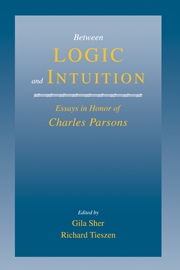Book contents
- Frontmatter
- Contents
- Preface
- I LOGIC
- II INTUITION
- Immediacy and the Birth of Reference in Kant: The Case for Space
- Geometry, Construction and Intuition in Kant and his Successors
- Parsons on Mathematical Intuition and Obviousness
- Gödel and Quine on Meaning and Mathematics
- III NUMBERS, SETS AND CLASSES
- Name Index
Parsons on Mathematical Intuition and Obviousness
Published online by Cambridge University Press: 02 December 2009
- Frontmatter
- Contents
- Preface
- I LOGIC
- II INTUITION
- Immediacy and the Birth of Reference in Kant: The Case for Space
- Geometry, Construction and Intuition in Kant and his Successors
- Parsons on Mathematical Intuition and Obviousness
- Gödel and Quine on Meaning and Mathematics
- III NUMBERS, SETS AND CLASSES
- Name Index
Summary
Introduction
In a series of important papers, Charles Parsons has argued that we have mathematical intuitions of certain “quasi-concrete,” mathematical objects, such as numerals or geometric shapes. With Kant and Hilbert, he maintains that these intuitions constitute some of our evidence for certain elementary mathematical truths, and that they can be used to explain the obviousness of these truths. I focus on his account of elementary number theory and attempt to clarify his views. I have no objection to the thesis that we intuit quasi-concrete objects, provided that we use more muted notions of intuition and quasi-concreteness than Parsons apparently does. I also raise doubts about using intuition to explain the obviousness of elementary mathematical truths. Let us begin with an exposition of his views.
Quasi-concreta and Intuitions of Them
According to Parsons, a quasi-concrete object is an abstract entity such as a symbol, a word, a color, or a sound, understood of course, as something over and above its utterances or instances, and yet also understood as capable of being given to us through the perception of them. As he puts it, “what they [quasi-concreta] are is determined by some instantiation or representation in the concrete,” and thus they differ from “pure” abstract objects, such as numbers, which have “no intrinsic concrete representation.” Unlike Penelope Maddy, whose views those of Parsons bring to mind, he does not maintain that quasi-concreta are located with their instances or have causal properties; they are like “pure” abstract entities in being outside of space-time and causally inert.
- Type
- Chapter
- Information
- Between Logic and IntuitionEssays in Honor of Charles Parsons, pp. 219 - 231Publisher: Cambridge University PressPrint publication year: 2000
- 1
- Cited by



